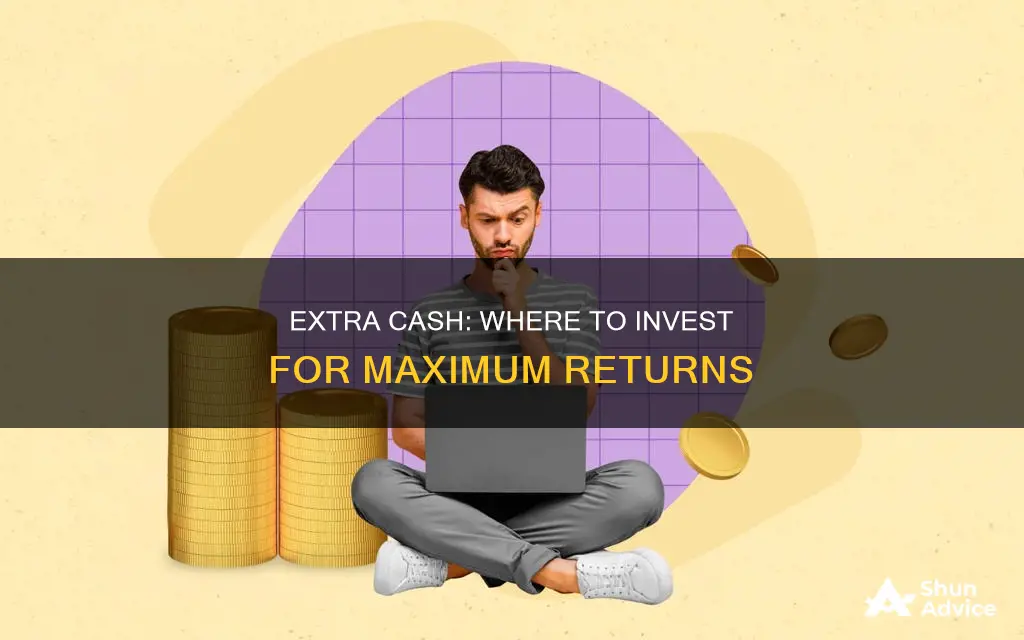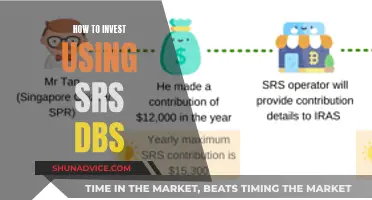
If you're lucky enough to have extra cash, it's important to make the most of it. While it can be tempting to splash out on something fun, it's worth considering the many ways you can invest your money to improve your financial situation.
One of the best ways to use extra cash is to pay off any high-interest debt, such as credit cards. This will save you money in the long run and help you avoid costly interest charges. It's also a good idea to boost your emergency fund, so you have enough to cover living expenses for at least three to six months.
If you're already debt-free and have a healthy savings buffer, you might want to consider investing in stocks, bonds, mutual funds, exchange-traded funds (ETFs), or even cryptocurrency. You could also look into real estate investment, either directly or through a real estate investment trust (REIT).
If you're unsure what to do, it's always a good idea to speak to a financial professional for advice. They can help you make an informed decision about where to invest your extra cash to achieve your financial goals.
| Characteristics | Values |
|---|---|
| Pay off debt | High-interest debt |
| Build an emergency fund | 3-6 months' worth of expenses |
| Invest in stocks | Dividend-paying stocks, defensive stocks |
| Invest in funds | Mutual funds, exchange-traded funds, money market funds |
| Invest in real estate | REITs |
| Invest in bonds | |
| Invest in cryptocurrencies | |
| Invest in yourself | Education, business |
| Save for retirement | 401(k), IRA, HSA |
What You'll Learn

Pay off high-interest debt
If you have extra cash, it is a good idea to pay off any high-interest debt you have. This is a smart way to use your money, as it will save you more money in the long run. Credit card debt, personal loans, and student loans are all examples of high-interest debt. By paying off these debts, you will free up more money each month and avoid costly interest charges.
High-interest debt, such as credit card debt, can be costly, with interest accruing daily. Making a large payment towards these debts can help you save money in the long run. If you have multiple credit cards with balances, it is a good idea to focus on paying off the one with the highest interest rate first. This will help you reduce the amount of interest you pay over time.
It is important to have a plan in place to pay off any future credit card balances each month to avoid accumulating more high-interest debt. This can help you stay on top of your finances and ensure that you are not paying more than you need to in interest.
Using your extra cash to pay off high-interest debt is a financially savvy move that can help you achieve your long-term financial goals. It may not be the most exciting option, but it is a smart way to use your money wisely and reduce your overall debt.
In addition to paying off high-interest debt, it is also important to have an emergency fund with three to six months' worth of living expenses saved. This will help you be prepared for unexpected expenses, such as medical bills or household repairs, without having to rely on high-interest credit cards or loans.
Cashing Out Investments: Using the Cash App to Withdraw Funds
You may want to see also

Build an emergency fund
Building an emergency fund is a crucial step in achieving financial security. This fund will help you navigate unexpected expenses, such as car repairs, medical bills, or income loss, without dipping into your investments or going into debt. Here are some detailed tips to help you build a solid emergency fund:
Set Clear Goals:
Start by determining how much you want in your emergency fund. A common recommendation is to save enough to cover your living expenses for three to six months. However, this number can vary depending on your situation. Consider your monthly expenses, any dependents you have, and any other financial responsibilities. Setting a clear goal will help you stay motivated and focused.
Start Small and Automate:
Don't be intimidated by the total amount you're aiming for. You can start small and build your savings over time. Set aside a manageable amount regularly, such as $50 or $100 per month. Automate your savings by setting up recurring transfers from your checking account to your savings account. That way, you save effortlessly without even thinking about it.
Create a Savings Habit:
Consistency is key when building an emergency fund. Make saving a habit by setting a specific goal, creating a system for regular contributions, and monitoring your progress. Celebrate your successes along the way, and don't be afraid to treat yourself now and then. This will help you stay motivated and committed to your savings journey.
Take Advantage of Extra Income:
Look for opportunities to boost your emergency fund. For example, if you receive a tax refund, a bonus, or a cash gift, consider putting all or part of it into your emergency savings. This strategy can help you reach your goal faster.
Choose the Right Account:
Select an account that is safe, accessible, and separate from your day-to-day spending money. Consider a basic savings account or a money market account linked to your checking account. Look for an account that offers a small annual yield without any annual fees. You want your money to be easily accessible when needed but not so readily available that you're tempted to spend it on non-emergencies.
Prioritize Emergencies:
Define what constitutes an emergency for you. While not every unexpected expense is a full-blown emergency, stay consistent and only tap into your emergency fund for true financial shocks. Replenish the fund as soon as possible after using it, and continue to build it over time.
Remember, building an emergency fund is a gradual process, and it's essential for your financial well-being. Start with small, manageable steps, and you'll be on your way to achieving financial security and peace of mind.
Cash App Investment Options: Where to Put Your Money
You may want to see also

Invest in stocks, bonds, mutual funds, or exchange-traded funds
Stocks, bonds, mutual funds, and exchange-traded funds (ETFs) are all investment vehicles that can help you reach your financial goals. Here's a detailed look at each of these options:
Stocks
Stocks represent ownership in a company, and they are traded on major exchanges like the New York Stock Exchange or Nasdaq. When a company needs to raise capital, they issue shares of stock, which can be purchased by investors. The value of a stock fluctuates based on the company's financial performance and other market factors. Stocks are considered high-risk investments due to their volatile nature, but they can also offer high rewards. It's important to do your research before investing in individual stocks.
Bonds
Bonds are fixed-income investments, also known as debt investments. When you purchase a bond, you are essentially loaning money to a company or government. Bonds typically pay a steady income, known as interest, over a specified time frame. At the end of the period, the bond issuer repays the principal amount (the original loan) plus interest. Bonds are generally considered lower-risk than stocks, but they still carry the risk of default, where the issuer may not be able to repay the principal.
Mutual Funds
Mutual funds are baskets of investments, professionally chosen and managed. By investing in a mutual fund, you own shares of the fund, which in turn owns a diverse range of individual securities. Mutual funds can include a mix of stocks, bonds, and other assets, providing investors with a diversified portfolio. Mutual funds are priced once per day at the end of the trading day, and they usually require a minimum dollar investment amount.
Exchange-Traded Funds (ETFs)
ETFs are similar to mutual funds in that they are also baskets of securities, including stocks, bonds, and other assets. However, ETFs are traded on major exchanges throughout the day, like stocks. Many ETFs are passively managed, meaning they aim to mirror the performance of a market index. ETFs offer potential diversification benefits, lower costs, and tax advantages, making them a popular investment choice.
When deciding where to invest your extra cash, it's important to consider your financial goals, risk tolerance, and investment horizon. Diversification is also key to building a robust investment portfolio. Consult with a financial advisor to determine the right mix of stocks, bonds, mutual funds, and ETFs for your specific needs.
Understanding Cash Flow: Investing Activities Explained
You may want to see also

Invest in real estate
There are many ways to invest in real estate, from owning physical property to online crowdfunding platforms. Here are some of the most common strategies:
Buy REITs (Real Estate Investment Trusts)
REITs allow you to invest in real estate without actually owning physical property. They are similar to mutual funds and are companies that own commercial real estate such as office buildings, retail spaces, apartments, and hotels. REITs tend to pay high dividends, making them a common investment choice for those seeking regular income or retirement investments. You can buy and sell shares of REITs through a brokerage account, and they are generally more liquid than other real estate investments.
Use an Online Real Estate Investing Platform
Online real estate investment platforms connect developers with investors who want to finance projects through debt or equity. These platforms often require a significant amount of money to invest and may only be open to accredited investors. They tend to be illiquid, meaning you can't easily sell your investment, and there may be fees involved.
Invest in Rental Properties
This strategy involves buying properties to rent out to tenants. You can do this by purchasing a multi-unit property or a single-family home. It can provide a steady cash flow and potential appreciation over time but requires a lot of work, such as finding and vetting tenants, handling maintenance, and dealing with repairs. You can hire a property manager, but this will cut into your returns.
Flip Properties
Property flipping involves buying an undervalued home, renovating it, and then reselling it for a profit. This strategy can be risky and requires a good understanding of the real estate market and renovation costs. It can also be costly, especially with the current high interest rates and building material prices.
Invest in Your Own Home
Purchasing your own home is a common way to invest in real estate. You build ownership over time by making mortgage payments, and you may be able to cash in on the equity when you sell if your local market is strong. However, returns on primary residences tend to be lower than other real estate investments, and there are costs to consider, such as maintenance, repairs, insurance, property taxes, and interest on your mortgage.
Real Estate Investment Groups (REIGs)
REIGs are ideal for those who want to own rental real estate without the hassle of hands-on management. They are similar to small mutual funds, where a group of investors pools their money to buy or build rental properties. A company manages the properties, and in exchange, they take a percentage of the rent. This option provides income and appreciation potential but may come with fees similar to mutual funds, and there is a risk of unscrupulous managers.
Real estate investing can be a great way to diversify your portfolio, but it's important to consider the risks and costs involved, especially when investing in physical property.
Uncertain Future Cash Flows: Navigating Investment Project Analysis
You may want to see also

Invest in yourself
Investing in yourself is a sure-fire way to get a return on your investments. It means actively working towards your personal growth and well-being. This could mean learning new things, honing your skills, or just making sure you're mentally and physically healthy. Here are some ways to invest in yourself:
- Embrace lifelong learning: Education doesn’t end once you leave the classroom. You can build your skill set and feed your passions with lifelong learning. There are many free online resources to help you get started on your financial journey, from online courses and money tips to resources and tools.
- Prioritize your mental health: Check in with yourself regularly to manage stress levels and prevent burnout. Give yourself permission to take a break, make mistakes, and set boundaries.
- Set achievable goals: These goals don’t have to be sweeping, long-term goals. They can be as simple as setting up autopayments with your bank or limiting eating out to once a month.
- Find a mentor: A mentor can help you navigate your finances and get closer to reaching your financial goals.
- Keep a journal: Journaling can help you manage stress, identify issues, and solve problems. It’s also a great place to practice gratitude and set goals.
- Break bad habits: Make a list in your journal of all the reasons why you want to break a bad habit and the steps you’re going to take to get rid of it.
- Get organized: Establish an effective organizational system for your finances, office, and home.
- Stop procrastinating: Make a list of all the things you’ve been putting off and devise a plan to get them done. Start with the easier tasks first, then tackle the harder ones.
- Cut out the clutter: Go through the social media accounts you follow and pare them down to only the ones that inspire you, make you laugh, or educate you. Do the same with the people, items, food, and habits in your life to brighten and lighten your year.
- Create a budget: Track your finances in a money diary, list your expenses, and develop a budget that is attainable and will help you reach your financial goals.
Remember, investing in yourself will not only improve your own life but will also equip you to make a positive impact on others.
Cash Investment Strategies: Your Guide to Profitable Opportunities
You may want to see also
Frequently asked questions
Financial advisors recommend paying off any high-interest debt, such as credit cards, first. This frees up more money every month and helps you avoid costly interest charges.
It is recommended to have an emergency fund that can cover your living expenses for at least three to six months. This will protect your investments in case of unexpected events.
You can then start investing. You can invest in stocks, bonds, mutual funds, exchange-traded funds (ETFs), or real estate. You can also open an individual retirement account (IRA) or contribute more to your existing retirement plan.
You can invest in yourself by funding your education or that of a family member. You can also consider investing in a business or startup.
You can save it in a high-yield savings account or money market account, which typically offer higher interest rates than traditional savings accounts.







